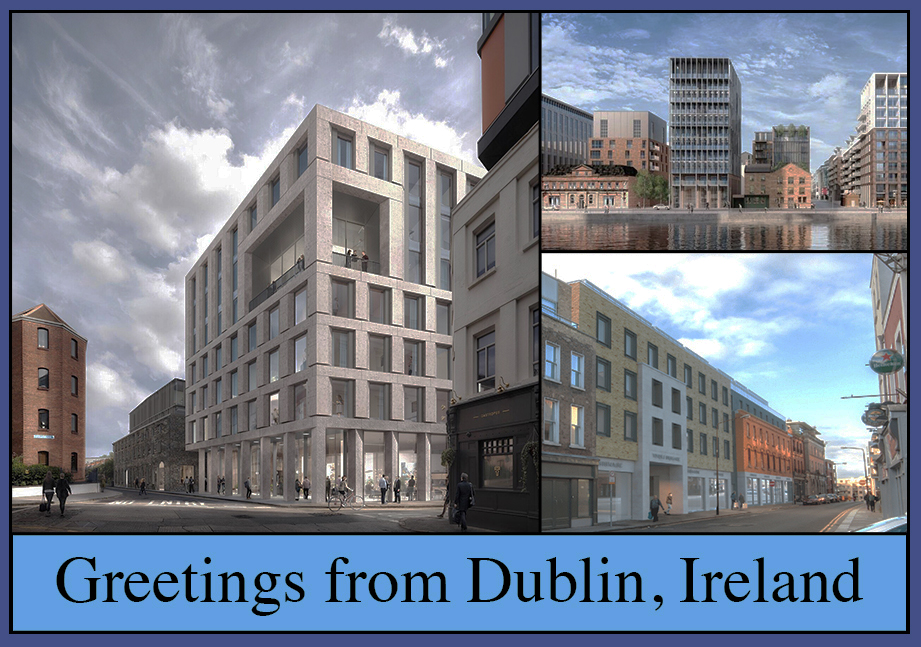Temporary Tenant
2020 - 2022
Having moved back to Dublin at the start of the pandemic after a five-year stint in London I found myself quarantined in an apartment. During my daily lockdown walks I soon realised that my grandparents and great grandparents grew up and lived in buildings within my 2K walking zone, all of which are now long gone, demolished, lost to gentrification and the rezoning of the city in the 1940s. I felt a huge sense of belonging in Dublin, yet a huge sense of distance and loss. Many of the venues which I used to DJ and socialise in, the places where I met most of my friends, are now also gone, lost to the continuous onslaught of greedy developers who are replacing all of the city's cultural spaces with hotels and office blocks. Rents have sky-rocketed in recent years forcing many out of the city and making it unattainable for Artists to remain.
I started to film my daily walks during the Covid-19 lockdown as Dublin became an eerie place due to a lack of people on its streets. With all the pubs, clubs and restaurants closed it became a shell of city, and laid bare how much it’s geared towards the tourist, the consumer and the temporary tenant. Had the pandemic given us a glimpse into the city of the not-so-distant future, one void of residents and culture? I began watching old 1920’s films about cities, a genre known as City Symphonies. Generally, these films celebrated the splendours of modernity and presented the city as the film’s protagonist rather than just a setting for actors. They combined both documentary and narrative film practices with experimental techniques, using the latest film technologies to simulate the fast pace and life of a bustling city. Similar in structure to that of a musical symphony, they often used montage featuring machinery, cars and people to project the daily rhythm of urban industrial life.
Dziga Vertov’s ‘Man with a Movie Camera’ follows a city in the 1920s Soviet Union throughout the day, from morning to night. The city is Vertov’s film is made up of footage collected over three years in three different cities in the Soviet Union. By using a single city and instead choosing to make it a mixture of three different cities, it demonstrates a Soviet ideology as it's a celebration of the Soviet state as a whole rather than an individual city. Vertov also chooses to open the film with an audience in a cinema watching the film, with shots later on of the editor editing the film and shots of himself filming the film throughout, making it not just about the city but also about the process of film making and editing, drawing attention to its own mode of production. I decided to make a new version of a city symphony using Dublin city as the protagonist, and use this remake of this 1920’s genre as a study into the history and materiality film and its relationship to the city. By contrasting the Soviet cities in Vertov's 'Man with a Movie Camera' with the Neoliberal city of the now / near future, I question what Dublin city is becoming and who is it for? The film is scored by composer Tommy Brooks.
I started to film my daily walks during the Covid-19 lockdown as Dublin became an eerie place due to a lack of people on its streets. With all the pubs, clubs and restaurants closed it became a shell of city, and laid bare how much it’s geared towards the tourist, the consumer and the temporary tenant. Had the pandemic given us a glimpse into the city of the not-so-distant future, one void of residents and culture? I began watching old 1920’s films about cities, a genre known as City Symphonies. Generally, these films celebrated the splendours of modernity and presented the city as the film’s protagonist rather than just a setting for actors. They combined both documentary and narrative film practices with experimental techniques, using the latest film technologies to simulate the fast pace and life of a bustling city. Similar in structure to that of a musical symphony, they often used montage featuring machinery, cars and people to project the daily rhythm of urban industrial life.
Dziga Vertov’s ‘Man with a Movie Camera’ follows a city in the 1920s Soviet Union throughout the day, from morning to night. The city is Vertov’s film is made up of footage collected over three years in three different cities in the Soviet Union. By using a single city and instead choosing to make it a mixture of three different cities, it demonstrates a Soviet ideology as it's a celebration of the Soviet state as a whole rather than an individual city. Vertov also chooses to open the film with an audience in a cinema watching the film, with shots later on of the editor editing the film and shots of himself filming the film throughout, making it not just about the city but also about the process of film making and editing, drawing attention to its own mode of production. I decided to make a new version of a city symphony using Dublin city as the protagonist, and use this remake of this 1920’s genre as a study into the history and materiality film and its relationship to the city. By contrasting the Soviet cities in Vertov's 'Man with a Movie Camera' with the Neoliberal city of the now / near future, I question what Dublin city is becoming and who is it for? The film is scored by composer Tommy Brooks.
Temporary Tenant, 14:40 mins (2:20 min excerpt))
